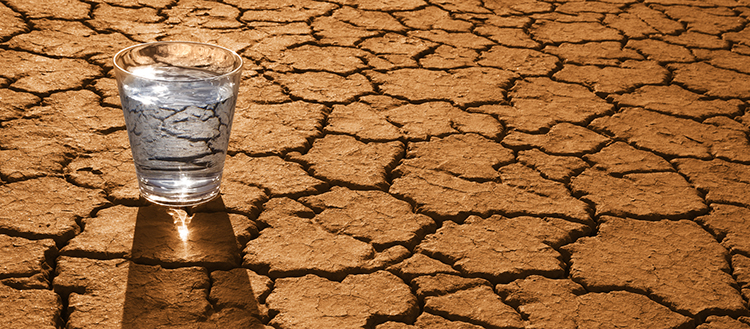Drought — a cause of riots

All rights reserved
The scientific community has been working on the possibility of a relationship between periods of drought and rioting for several years. The University of Geneva (UNIGE), operating in partnership with the universities of Heidelberg (Germany) and Lucerne (Switzerland), has formally verified this hypothesis by studying almost 1,800 riots that occurred over a 20-year period in sub-Saharan Africa. The researchers observed a systematic link between the sudden depletion of water resources and the outbreak of unrest. They also succeeded in quantifying the impact of geographic and social factors on the same link. The findings, which underline the importance of the role of political institutions in the event of a drought, can be read in the Journal of Environmental Economics and Management.
Several case studies have reported that drought provokes tensions in the affected population. For example, when a period of drought hits a particular region, it has been shown that there is a drop in agricultural production and income; food becomes scarcer and prices rise; and towns no longer receive adequate supplies — all of which leads to outbreaks of rioting. But is there a systematic link between drought and riots? Most of the data used in the research has been too aggregated until now to provide an accurate answer: researchers based their analyses on figures indicating the average amount of rainfall for each country over a year and the manifestation of unrest in the same year per country. However, the data was too unrepresentative of the quantity of water actually required by the populations. Moreover, it was unsuitable for studying riots, which are typically of a local nature, and usually shorter and more explosive than civil conflicts. It was clear, therefore, that the statistics needed to be refined and each conflict looked at in more detail according to the region, climate and inhabitants.
Drought adds fuel to the flames
A team of economists — including Jérémy Lucchetti, a professor in UNIGE’s economics and management faculty (GSEM) — decided to focus their studies on the case of sub-Saharan Africa. This region, characterised by an economic structure that heavily depends on the presence of water, is ideal for demonstrating the systematic existence of the link. Forty-three countries with a minimum of one million inhabitants were analysed.
The researchers used a drought indicator devised by hydrologists, the Standardised Precipitation-Evapotranspiration Index (SPEI), which measures precipitation in a given month over a region and subtracts the amount of water lost through evaporation. The SPEI can be used on a very detailed scale: for each 50km by 50km area, it indicates the month-by-month availability of water over a period of approximately 100 years. The economists subsequently cross-referenced the SPEI information with data from the Social Conflict Analysis Database (SCAD), which lists 1,800 incidents of rioting between 1990 and 2011, precisely geolocated in sub-Saharan Africa (location, beginning of the conflict and duration). As professor Lucchetti explains: “The problem was to look beyond the simple drought-conflict correlation and examine the other factors potentially linked to these two aspects that could misrepresent the relationship between drought and conflict.” Lucchetti gives the following example: “Rebel groups, for instance, that take up position outside a capital in a desert area may cause riots without there being a direct link with a drought in the region, which could feed into a spurious correlation.”
Professor Lucchetti further explains that the researchers had to be careful not to consider drought as the main cause of a riot. “In order of importance, it is political, economic and social causes that create tension. Droughts are a factor that add fuel to flames that are already burning”.
Droughts raise the risk of rioting from 10% to 50%
The researchers, who controlled for a very wide range of ancillary variables, found that a period of drought increases the overall possibility of rioting by 10% in a given month in any region, whether it is a desert or not, and regardless of whether it is close to a city. “But, points out Lucchetti, if you cross-reference other geographical and social factors, this percentage rises dramatically.” In fact, three key elements play a leading role in the likelihood of drought-related riots. The first is population density: the more densely populated a region is, the greater the need for water. If there is shortage of “blue gold” in the most dense areas, the probability of a riot breaking out jumps by 50%. Similarly, if a region where there are no lakes or rivers is struck by drought, the risk of a conflict breaking out is multiplied by two; by contrast, areas boasting lakes and rivers see the same risk decreasing proportionally. Finally, if several different ethnic groups share the same water resource within the same region, traditional institutional arrangements may temporarily collapse in the event of a shortage, swelling the risk of conflict by a factor of two.
The study shows the systematic and immediate link between droughts and rioting. The economists found that drought-related conflicts erupt in the same month as the onset of a water shortage, demonstrating that populations react quickly to a problem that affects agriculture, the economy and health. Professor Lucchetti concludes: “We now have to use this data to examine in detail what mechanisms could be put in place by political institutions to avoid riots, such as setting up redistribution systems in areas affected by drought.”
Contact: Jérémy Lucchetti, +41 22 379 82 81
15 Sept 2017